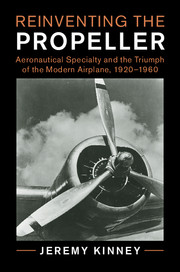Book contents
- Frontmatter
- Dedication
- Contents
- List of Figures
- List of Tables
- Preface
- Acknowledgments
- List of Abbreviations
- A Note on Terms
- 1 Introduction: The Propeller and the Modern Airplane
- 2 “The Best Propeller for Starting Is Not the Best for Flying”
- 3 “Engineering of a Pioneer Character”
- 4 A “New Type Adjustable-Pitch Propeller”
- 5 “The Propeller That Took Lindbergh Across”
- 6 “The Ultimate Solution of Our Propeller Problem”
- 7 No. 1 Propeller Company
- 8 A Gear Shift for the Airplane
- 9 Constant-Speed
- 10 “The Spitfire Now ‘Is an Aeroplane’ ”
- 11 A Propeller for the Air Age
- 12 Conclusion: The Triumph and Decline of the Propeller
- Essay on Sources
- Index
8 - A Gear Shift for the Airplane
Published online by Cambridge University Press: 20 April 2017
- Frontmatter
- Dedication
- Contents
- List of Figures
- List of Tables
- Preface
- Acknowledgments
- List of Abbreviations
- A Note on Terms
- 1 Introduction: The Propeller and the Modern Airplane
- 2 “The Best Propeller for Starting Is Not the Best for Flying”
- 3 “Engineering of a Pioneer Character”
- 4 A “New Type Adjustable-Pitch Propeller”
- 5 “The Propeller That Took Lindbergh Across”
- 6 “The Ultimate Solution of Our Propeller Problem”
- 7 No. 1 Propeller Company
- 8 A Gear Shift for the Airplane
- 9 Constant-Speed
- 10 “The Spitfire Now ‘Is an Aeroplane’ ”
- 11 A Propeller for the Air Age
- 12 Conclusion: The Triumph and Decline of the Propeller
- Essay on Sources
- Index
Summary
In October 1934, American-designed and built Douglas DC-2 and Boeing Model 247-D commercial airliners finished second and third behind a special-purpose British de Havilland DH.88 Comet air racer in the 11,300-mile London-to-Melbourne MacRobertson Trophy Race. The New York Times hailed the performance of the two revolutionary aircraft as a victory for American aeronautical technology and its superiority over European technologies. The diminutive British entry, equipped with two propellers capable of only changing their pitch once in flight, carried only its pilot and copilot. Hamilton Standard controllable-pitch propellers enhanced the overall performance of the much larger transports, especially Dutch KLM's DC-2 Uiver, as they carried passengers and mail much like they would have in regular commercial operations (Figure 17). The crews of the DC-2 and 247-D lost the race and the resulting $50,000 prize, but won the international competition for aeronautical technological superiority. Introduced to the world through the MacRobertson Race, the variable-pitch propeller was a critical technology to the Aeronautical Revolution of the late 1920s and early 1930s in the United States and Great Britain.
Aircraft designers drew upon an impressive listing of aerodynamic, propulsive, and material innovations as they worked to meet the specifications issued by their military and commercial clients. Streamlined design involved the removal or redesign of drag-inducing structures such as fixed landing gear, engines and radiators, struts and wires, open cockpits, and armament to increase overall performance. Flaps mounted on the trailing edge of the wings changed the aerodynamic shape of the wing to create more lift at takeoff and landing. Lightweight air-cooled radial engines offered increased horsepower while the NACA's cowling reduced drag and improved cooling at the same time. Structural improvements in the form of all-metal construction, internally supported cantilever wings, and retractable landing gear resulted in further efficiency and operational durability. How those innovations were incorporated into a particular design and in what combination was the key to realizing the modern airplane.
Despite the promise of increased performance offered by the variable-pitch propeller, the aeronautical community did not immediately welcome its introduction. The engineers and companies developing this new technology had to overcome much opposition. Besides the economic and technical arguments that the new propeller's cost, weight, and complexity of operation were too great, there was a larger reason for its limited introduction in the early 1930s.
- Type
- Chapter
- Information
- Reinventing the PropellerAeronautical Specialty and the Triumph of the Modern Airplane, pp. 204 - 234Publisher: Cambridge University PressPrint publication year: 2017



